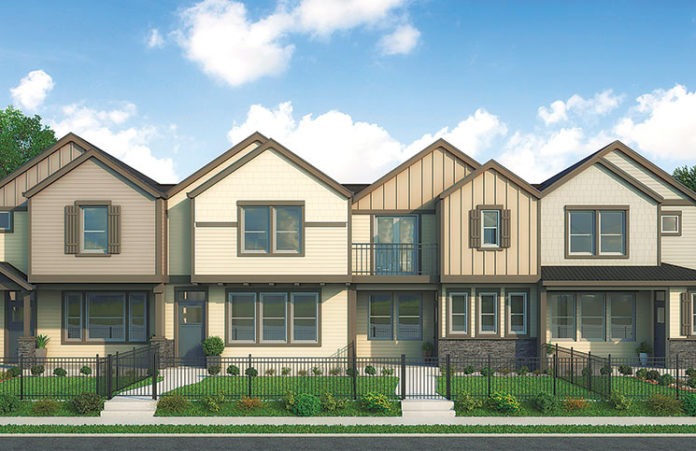Clark County’s real estate market is likely to cool a bit in 2019, but that cooling is only likely to move the market from a red hot inferno down to just sizzling, local realtors say.
In November, the most recent month with available statistics, sales numbers dropped a bit from prior years. The 564 new pending residential sales that month marked a 14.2 percent drop from November 2017, and a 17.8 percent drop from October 2018. But that doesn’t really mean the overall market is slowing. November and December are usually slow months, and realtors are already seeing an uptick this January.
“This is traditionally a slow time of the year, but the market is still accelerating,” said James Holcomb, president of the Clark County Association of Realtors. “We’ve seen a rapid pace of price increases the last few years, and while the market is bound to slow a little, it is still competitive in many areas. Interest rates have influenced the market, as well as housing availability at certain price points.”
Mike Lamb, a real estate broker with Windermere Stellar, said he’s already seen an uptick in January. The market has been so hot that even if things look like they’re slowing down, they’re still extremely active compared to the historical average, he said.
“Activity seems to have picked up nicely in January,” Lamb said. “I think a lot of this is just a matter of perspective. From September on, things were slower than they were in spring, but it’s not uncommon for things to slow down at the end of the year. We had a gangbuster spring, and if you compare anything to that, it looks like a lot less. But 2018 was our third or fourth best year since 2005, even if it looks slow.”
The slower November sales also caused the backlog of pending sales to shrink 12.5 percent from October to 1,021.
Terry Wollam, owner of Wollam and Associates in Clark County, which is part of Remax, said he sees some compression in the market. Housing at the top of the market has slowed, but affordable housing construction is up and moving at a very rapid pace, he said.
“We’re seeing more activity on the affordable side,” Wollam said. “Higher-end home sales have been a little more stagnant, which is to be expected with trade negotiations with China and fluctuations in the stock market.”
Strong demand for affordable housing throughout Clark County is likely to continue, especially in East Vancouver, Camas, the I-5 corridor and areas close to Portland with good schools, he said.
“I would say there’s been a push the last few years for affordable housing,” Wollam said. “We’ve seen compression between the top of the market and affordable housing.”
Still, some uncertainty remains about pricing of homes due to fluctuations in materials costs because of the trade war with China and also due to some new regulatory requirements, he said.
“There’s not one thing that’s impacting pricing of homes – there are a list of things,” Wollam said. “There are some impacts with the trade war with China that are affecting home prices. There are also new requirements from the state Department of Ecology that could cause increases in site building costs.”
Another thing affecting prices is a bit of a market correction for homes that weren’t priced correctly. Some homes on the higher side of the market were vastly overpriced, which slowed sales, Lamb said.
“Part of what’s causing people to think it’s slow, we’ve seen a lot of price reductions,” Lamb said. “But there were a lot of things that weren’t priced right to begin with. Things that are priced right sell very well.”
A 2019 Housing Market Outlook report from Penrith Home Loans in Vancouver is projecting two mortgage interest rate hikes will happen during the year, with rates eventually topping 5.5 percent. The rates are still near historic lows, but they’re starting to tick upwards.
The report also projects moderate housing inventory growth of less than 7 percent, a shift from luxury- to entry-level construction and a slowdown of appreciation, with median home prices rising 2 to 3 percent.
“2018 showed continued signs that demand is outpacing supply,” Holcomb said. “My guess is that will continue into 2019, but at a slightly less aggressive pace than we have seen in the last couple years.”
Outlying parts of Clark County, including Battle Ground, Washougal and Ridgefield, are all seeing booms of new construction, generally single-family homes, and that’s likely to continue, Wollam said.
“You will not see price increases in those areas, either,” Wollam said. “They’re mostly building single-family homes. Our outlying areas – there’s more land availability at a lesser price.”
Wollam also thinks months in inventory numbers – which show how quickly homes sell – will continue to move upward a bit at interest rates and prices in the overall market continue to climb.
“There’s potential for a slight recession at the end of 2019 and the start of 2020,” Wollam said. “But then we think we’ll see an uptick after that. I don’t think you’ll see less sales activity. There’s a huge pent up demand around Millennial-aged buyers looking for affordable homes. The largest sector out there is that Millennial type buyer. Boomers are downsizing. And Gen-X, some of them are moving up to larger homes now.”
Lamb said he doesn’t expect demand to drop off anytime soon. Clark County is a big draw for people hoping to avoid Oregon’s tax structure, and also those that want to live close to the Portland Airport, and those two factors are likely to keep Clark County homes in high demand, he said.
“Even if we see the economy cool, I suspect housing will continue to do well, especially in this area,” Lamb said. “I don’t see anything on the horizon for Clark County that isn’t reasonably positive. It may not be as strong a sellers market as it has been, but it’s still strong.”



